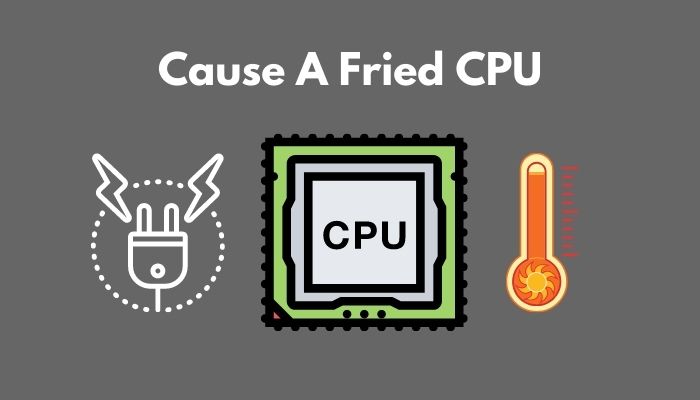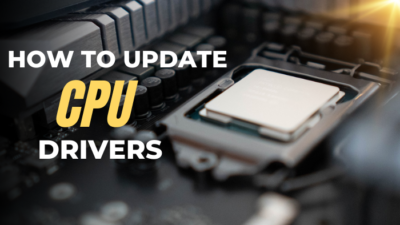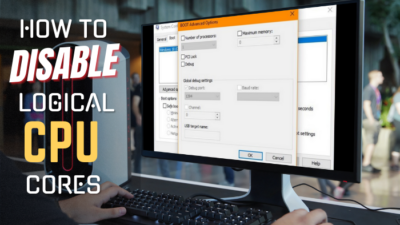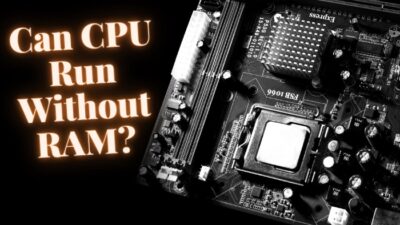As a beginner tech geek, your curious mind wants to test how far can you stress a CPU. Your adrenaline pumped high enough to stress test the CPU without a cooler! But, all of a sudden your curious mind knocked at the door and asked, will you end up with a fried CPU?
Let’s not get worried too much. I am here to make you stress-free. As a hardware engineer, I have performed a lot of stress tests and overclocked an extended amount of CPUs and GPUs over the past 10 years. You can count on me.
To continue your geekiness and get all the answers, try to read till the end. I hope you will get all your answers.
Can a CPU Get Fried for Overheating?
A CPU can be fried due to overheating is a myth for the modern gen CPUs. No, you won’t end up with a fried CPU if you overheated it too much. Now modern CPUs are designed with a lot of safety features. These top-notch architectural-based CPUs will shut down if it gets too hot. Fail-safe is quite a blessing feature.
Speaking of a fried CPU, it means due to overheating CPU’s electrical components like transistors, diodes or capacitors are burned up. You will find overheating happened with some CPUs which didn’t have any fail-safe features or were overclocked by pushing high voltage. Sometimes using a faulty motherboard and faulty PSU can do this type of damage.
If your motherboard’s BIOS is corrupted and didn’t follow the procedures while it’s got too hot, then there is a high chance you will end up with a fried CPU. PSU sometimes can be the reason behind this. A faulty PSU can overheat the CPU by passing high voltage to it.
A faulty CPU can also be the reason to kill itself. If an electrically damaged CPU failed to initiate the fail-safe or becomes unable to shut down while overheating then it would fry.
So, you can end up with a fried CPU if you have the worst luck. But this scenario is quite rare these days.
What does Cause a Fried CPU?
As I have told you earlier a CPU can be fried if you are having a stroke of bad luck. Sometimes faulty hardware can cause this problem. Which will cost you a lot of money as CPUs won’t come cheap.
All the semiconductors have a maximum temperature limit. If it exceeds that limit it will damage the chip. In the previous time, running a CPU without a cooler, or lack of proper cooling solution like a faulty CPU cooler, insufficient airflow in the case, or running a CPU in a high-temperature environment were responsible for a fried CPU.
But as we see, modern CPUs have advanced thermal protection. CPU will shut down automatically if it reaches a high temperature. If CPU temperature rises high due to high clock speed then it reduces the clock speed to a lower level.
If you are using a faulty motherboard that has damaged VRM can fry up your CPU. A voltage regulator module or VRM is responsible for supplying accurate voltage to the microprocessors and the chipset. If it got damaged it can fry up the CPU.
Voltage or temp which can kill a CPU by frying it up?
It depends on each other. There’s a limit of how much voltage a CPU can take. If you push high voltages more than the safety line then the CPU will heat up a lot more than you can imagine. Voltage and temperature are like spice and curry. The more you put spice in a curry the more it will become tasty. But if you put too much it will ruin the curry.
Let’s say, you are running your CPU with 1.35 Volt then you will have to maintain your temperature under 85 celsius, it is quite safe. If you pushed it higher like 1.9 volts then you should think twice. You will definitely need a liquid nitrogen cooler to cool it down. CPU will get too much hot which is enough to fry it up.
Voltage under 1.4 with proper cooling is a sweet spot for your CPU.
Overclocking your CPU by overriding the temperature limit and altering the voltage can also cause a CPU to fry. Overriding the limits will block the safety features, which is too bad. Bad PSU can fry the CPU too. A faulty PSU can fill the CPU with excess voltage which can kill it. So, it is important to figure out faulty hardware to ensure the safety of your pc.
How to Check a Damaged CPU
Working with a damaged CPU can give you a headache. This will bring chaos to your entire pc because the CPU is the brain behind the total system. All the works are processed and executed by it. So, checking for a damaged or fried CPU is a must, let’s dive deep into it. Shall we?
Here are some quick factors to check for a damaged CPU:
- You will see a blue screen of death frequently which can be a sign of a damaged CPU.
- If your CPU is overheating instead of having a decent CPU cooler running and proper voltage applied, then it is possible your CPU is damaged.
- A continuous beeping sound may indicate a hardware issue. BIOS always scans for PC and hardware issues, and a beeping sound happens to alert the user. If you notice five to six times beeping, then it may indicate CPU damage. Different beeping sound means different issues.
- If the fans run at full speed while your pc is turned on without the OS loading, then this might be a sign.
- After turning it on, If you see a freezing OS within a short period of time but no overloaded work is going on in the background. CPU shows a high temperature at the same time, and then the CPU may be damaged.
- If your pc turns off immediately after turning it on, then check your CPU. Check the CPU by opening the motherboard. If you see burn marks around the processor or a burning smell coming out of it, then it is high time to change the processor; it’s fried up.
So, if you faced the above-mentioned scenarios, then try to look for a technician or go to customer care if you have a warranty left.
How to Avoid a Fried CPU
If you want your pc to run smoothly, then you have to keep an eye on your CPU. CPUs are so costly now these days so it is very important to take precautions. A fried CPU will give you a lifetime nightmare if you can’t afford another one.
Try to keep the temperature low all the time by using a decent CPU cooler. Stock coolers are sometimes not enough to cool down the CPU. Try to use an aftermarket air cooler or liquid cooler, it can be the best solution. You can monitor the CPU temperature to check the condition.
Avoid overclocking the CPU with high voltage. Don’t run the CPU at high temperatures all the time. It will reduce its performance. If there is no need to OC the CPU, then don’t do it.
Try to change the motherboard if it is faulty. Motherboards damaged VRM can supply overvoltage to the CPU, which can cause permanent damage. Other damaged components of the motherboards, like capacitors, can also cause hamper the CPU. Also, when you replace or upgrade the CPU, make sure to apply enough thermal paste.
Don’t use a damaged PSU, which can cause an electric surge, which is enough to fry the hardware components along with the CPU.
FAQs
Is it Possible to Fix a Fried CPU?
No, it’s not possible to fix a fried CPU. Try to replace it with a new one. It’s almost impossible to repair a fried CPU. If you find your CPU is fried, then immediately change it and go for a new one.
Can a motherboard fry a CPU?
Yes, it can. A faulty motherboard can supply high voltage to the CPU through a damaged VRM. It can burn the transistors and diodes in the CPU. So, a faulty motherboard can kill your CPU. Changing the motherboard asap will be the best decision to make.
How long does it take a CPU to degrade?
Your PC would degrade faster if you run it always with thigh temperature. Heat is the main culprit for a CPU. Five to eight years later, you may see lower performance from your pc, but the time depends on how roughly you use it. PSU can cause an electrical surge if it is damaged.
Try to avoid all types of damaged hardware. Sometimes old CPU can kill itself by heating itself so much if it fails to ensure fail-safe.
So, if you have gone through the entire article, I think you now know how to do all your geek experiments with the CPU by abiding by all the safety measurements. Try to reach me through comments if you fail to understand any topics.
Is thermal paste a must for a CPU?
Yes, it is very much crucial for the CPU. The thermal paste helps to spread the heat faster in the heatsinks. Without a thermal paste applied over the CPU, you will see high temperatures always.
Final Thoughts
So, in the end, all I can say is that the CPU can be fried up if you use faulty hardware. Overclocking the CPU by overriding the voltage can also be the reason. A motherboard with a damaged VRM can fry up the CPU with excess voltage. Try to change the mobo if it got damaged. It is also recommended to change a faulty PSU, which can cause an electric surge.
I hope your geek experiment with the CPU will be fun and out of confusion if you have gone through the entire article. Just pass a comment if you fail to understand any topic.




